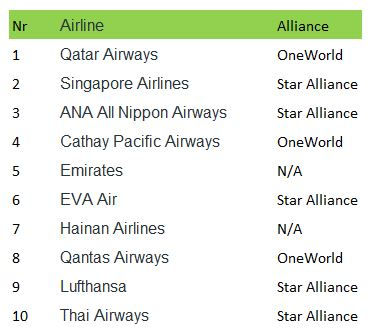Are airline alliances a proxy for service and comfort?
- flychickenflyyy
- Jul 1, 2019
- 3 min read
What the SkyTrax 2019 awards teach us about the value of the 3 global alliances.

As a frequent flyer, I fly different airlines all the time. Some of those airlines were the result of a specific choice - others were part of what I like to call a "package deal" to be able to get from point A to B. That "package deal" are the result of an alliance, where airlines are grouped to offer more destinations worldwide than ever before, while offering additional services to customers (getting your bags checked through, lounge access, etc). However, how sure are you to find the same standards of your preferred airline with the alliance partners? We tried to find out by looking at some data.
Every year, SkyTrax organises the World Airline Awards, where airlines and airports alike are ranked among their peers. Qatar won the prestigious price of best airline of 2019, closely followed by Singapore Airlines and the Japanese airline ANA. Star Alliance, of which those latter two are a member, was named best alliance for the year.
What is interesting about the airline ranking, is that they offer a full list of the top-100 airlines. And let this be an ideal set of data to compare how different alliance partners compare to each other within and across alliances.
In summary:
The 3 global alliances have a total of 59 full members
SkyTrax top-100 of best airlines contains 47 of the alliance members, or 80% of all members
Star Alliance has 5 airlines in the top-10 of best airlines; OneWorld has 3
SkyTeam's best ranked airline is Garuda on spot 12
Star Alliance, partly due to its size, has a 'tail-end' problem
Alliance Overview
There are 3 global airline alliances - all of them relatively young. Star Alliance saw the light in 1997, OneWorld in 1999 and SkyTeam in 2000.
Learn more about alliances and what they do here. Star Alliance is currently considered the best in the world according to SkyTrax, a title they are defending since 2016.

Star Alliance groups the highest number of top-comfort airlines
With Singapore Airlines and ANA among its ranks, Star Alliance hosts some big-hitters when it comes to service and comfort. It has 50% of the top-10 airlines according to SkyTrax amongst its members

Bigger is Better or Small is Beautiful?
This is where things get interesting - while the three alliances are quite alike when it comes to number of passengers transported or fleet size, they are very different when it comes to number of member airline. Star Alliance has 27 full members among its ranks, OneWorld 13 and SkyTeam 19. But is that necessarily a good thing?
With 27 airlines across the globe, Star Alliance groups a high number of airlines. On the one hand, this adds convenience for travelers. On the other hand, it leads to a lack of consistency in service and comfort.

This is what I like to call the "tail-end problem" of alliances. Let's zoom in on Star Alliance for instance: they have a lot of the top-notch airlines (as per graph above), but have a tail-end featuring rather disappointing airlines. For Star Alliance, this tail-end group includes airlines such as United, LOT Polish Airlines, China Airlines, Scandinavian Airlines SAS and Brussels Airlines. Having flown with most of those, I confirm the lower standards with regards to quality and service compared to the top-50 ranked ones. As a traveler, you have to be aware of which alliance partner is ensuring your connection.
When comparing Star Alliance with OneWorld (which groups much less airlines), there is a much smaller tail-end problem than at Star Alliance - hence providing a more consistent experience overall.
What are your thoughts? Which alliance do you prefer? And why? And do you bother about the tail-end problem?





Comments